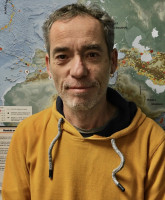Natural Catastrophes
Volcanic Eruption
Joint Research Initiative
United Kingdom
2018.12.31
Volcanic Risk Assessment in Asia
Assessing volcanic ash hazard footprints in Asia
In the language of insurance, a large volcanic ash plume represents what is commonly known as a low-probability, high-intensity event. To appropriately manage the risks posed by such disasters, insurers use complex models that generate a robust set of simulated events to estimate the damage and prepare for the financial impacts. “AXA protects many customers against volcanic eruptions, especially in Asia. To offer this kind of protection, we are asked by regulators and local teams to estimate the economic impact of an extreme eruption event ", explains Mathis Joffrain, head of the project on AXA’s side, and a senior natural catastrophes modeler at AXA Group Risk Management. "Because these events are extremely rare, this calculation is a challenge”.
Indeed, without information from analogous well-studied eruptions, ash dispersion models need to solve physics- based equations over large geographical scales, which is time- and resource-intensive, and thus computationally inefficient. Using recent advances in numerical modelling, the present project seeks to overcome this obstacle. The first aim of the project is to develop a computationally efficient probabilistic ash dispersal model that better simulates the hazard footprints. Once the model is ready, a country-specific version of the model will be developed, to quantify the spatial extent and intensity of volcanic hazard in countries within southeast Asia. “This is a significant undertaking, says Dr. Jenkins. it requires frequency-magnitude relationships and eruption source parameters to be defined for all credible eruption scenarios from all potentially active or active volcanoes in the country. For this, we aim to collaborate and liaise closely with local agencies, using their regional data to supplement large databases like the ones created by the Smithsonian Institution Global Volcanism Program (GVP) or the Large Magnitude Explosive Volcanic Eruptions (LaMEVE)”. Finally, the last work package will assess volcanic loss from a future hypothetical eruption at Mount Fuji in Japan. In other words, this final step will focus not just on hazard, but also on risk, coupling the previously developed ash hazard modelling approach with exposure and vulnerability assessments. “The effort will expand beyond solely major building damage, to cover critical infrastructures, agriculture and other causes for economic loss”.
Catastrophe models are highly complex in nature. They entail the pooling of various fields of expertise, including state-of-the-art statistical and mathematical methods, in-depth scientific understanding of the phenomena at play and, of course, the perspective of a practitioner. The present joint initiative represents a perfect opportunity for synergy of all these aspects. Furthermore, AXA’s strong involvement in Asia, its contact with real-world end users in countries within the region, will give the research societal relevance and help steer efforts towards the development of a practical tool.

Susanna
JENKINS
Institution
The University of Edinburgh
Country
United Kingdom
Nationality
British
Related articles
Natural Catastrophes
Climate Change
Wildfires
Climate Adaptation & Resilience
Global Warming
AXA Chair
Greece
AXA Chair in Wildfires and Climate
The consequences of climate change have never been as substantial and visible in such a wide range of places around ... Read more

Apostolos
VOULGARAKIS

